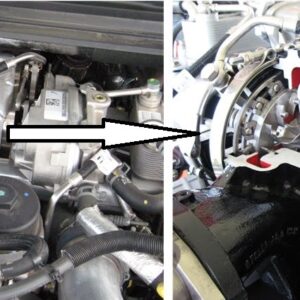Q: Where is the flywheel located on the car?
The flywheel is usually found in the engine’s rear end, between the engine and the clutch assembly. It’s often inside the bell housing, fastened to a flange on the side of the crankshaft that faces the transmission. Only manual cars have a flywheel.
The flywheel is a large, heavy disk on the end of the crankshaft. It connects the engine to the transmission through the clutch, enabling engine power to transfer to the drive wheels.
The flywheel in a manual transmission vehicle stores rotational energy. It helps maintain engine momentum, preventing stalling when the clutch disengages. It balances the engine so that it smooths out crankshaft vibrations. The harmonic balancer does this on the front of the crank.
The gear teeth on the flywheel are engaged by the starter drive as it spins the engine. The flywheel connects the engine to the transmission by way of the clutch.
Automatic transmission vehicles use the torque converter, which is bolted to a flex plate that is bolted at its center to the crankshaft. The torque converter does all the same things the flywheel does because it’s so heavy and full of fluid.
Some torque converter flex plates include the ring gear for the starter, and on those that don’t, the torque converter will include the starter ring gear.
Tips on How to Access the Flywheel
You can only access the flywheel after you remove the transmission and clutch assembly. You need to remove the shifter, exhaust, driveshaft, and starter.


It’s a good idea to drain the transmission fluid before you can remove the transmission.
After removing the transmission, you must remove the clutch pressure plate to access the flywheel. Use something like a wood block to wedge the flywheel in place, preventing it from moving while you remove the pressure plate’s bolts, unless you have a small impact wrench.
Always wear protective eye goggles and a face mask. The clutch is covered in toxic asbestos dust that you must avoid breathing in. You can spray the dust with water to moisten the dust, reducing the chances of the particulate matter from getting airborne. Use electric or manual tools to unbolt; avoid using air tools that might blow the dust into your face.
Any information provided on this Website is for informational purposes only and is not intended to replace consultation with a professional mechanic. The accuracy and timeliness of the information may change from the time of publication.

































